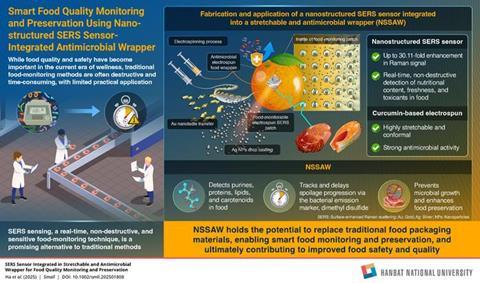Food quality and safety are crucial. However, conventional food-monitoring methods, including ribotyping and polymerase chain reaction, tend to be destructive and lengthy. These shortcomings limit their potential for broad applications. In this regard, surface-enhanced Raman scattering (SERS) sensing, with real-time, non-destructive, and high sensitivity capabilities, is a highly promising alternative.

In a new breakthrough, a team of researchers, led by Associate Professor Ji-Hwan Ha from the Department of Mechanical Engineering, Hanbat National University, Republic of Korea, has developed a two-in-one nanostructured SERS sensor integrated into a stretchable and antimicrobial wrapper (NSSAW) that not only monitors food directly on the surface but also actively preserves it. Their novel findings were made available online on 29 May 2025 and have been published in Volume 21, Issue 38 of the journal Small on 25 September 2025 (Back Cover).
The proposed wrapper incorporates a nanostructured SERS sensor—Au nano-arrays loaded with Ag nanoparticles—that delivers up to 30.11-fold Raman enhancement, enabling real-time, non-destructive detection of nutritional components, including purines, proteins, lipids, and carotenoids, and even the pesticide thiram on meats, fish, and fruit. At the same time, the curcumin-thermoplastic polyurethane (TPU) electrospun wrapper shows strong antimicrobial efficacy of 99.99% against S. aureus and 99.9% against E. coli, helping extend shelf life.
Farm-to-fork chain
Notably, NSSAW is highly stretchable and conformal, withstanding elongation of 716% and maximum stress of 52.3 MPa. The SERS layer is spontaneously integrated into it during fabrication via nanoimprint lithography, e-beam slanted deposition, and electrospinning with nanotransfer printing, indicating a practical route to scalable packaging.

“In cold-chain logistics and storage, the wrapper can help distributors decide when to ship and sell food by continuously tracking freshness and spoilage chemistry. In retail smart packaging, its stretchable, conformal, and biocompatible nature enables non-destructive, on-package checks of quality and nutrition markers—without any damage to food—supporting point-of-sale quality automation and transparent date labeling. Thus, the real-world uses of our technology span the entire farm-to-fork chain,” says Prof. Ha.
Tracking spoilage progression
Furthermore, NSSAW tracks spoilage progression over time by following the bacterial emission marker dimethyl disulfide, linking chemistry to freshness in a way that consumers and industry can interpret. This research is thus expected to open new horizons in monitoring the freshness and composition of human food.
READ MORE: DIY beeswax food wraps could be a lifesaver in conflict regions like Ukraine
“NSSAW can act as an on-food freshness indicator during consumer storage for home use and meal-kit delivery, linking chemical changes to easy-to-interpret signals over time. In addition, for high-value seafood and meats, quantitative tracking of purines such as hypoxanthine supports premium-grade verification and shelf-life decisions. Moreover, as active packaging, the curcumin-TPU, with its antimicrobial properties, complements sensing with preservation to extend shelf life in distribution and retail,” says Prof. Ha.
Over the next 5–10 years, packaging that both preserves food and continuously verifies its quality could move from pilot to mainstream. Leveraging the innovative technology presented in this study, retailers and consumers could rely on real-time, non-destructive quality signals instead of coarse date estimates—cutting waste, improving safety, and enabling smarter pricing and recalls.







No comments yet